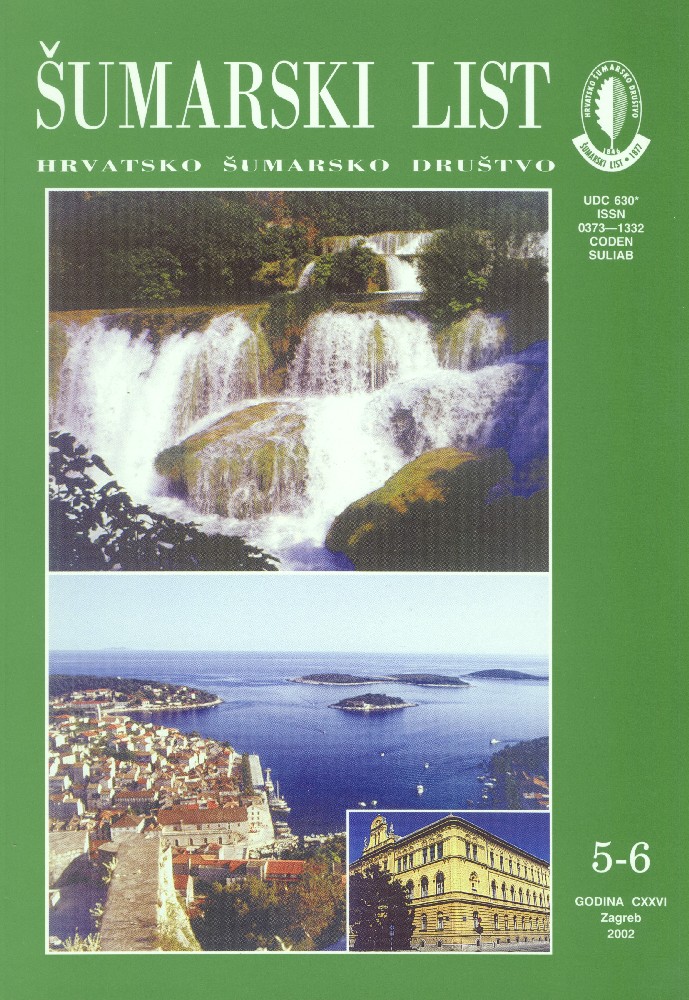
broj: 5-6/2002
pdf (26,8 MB) |
|
||||||||||||||
| IZVORNI ZNANSTVENI ČLANCI | ||
| Medak, J., Slade, D., Vukelić, M., Medvedović, J. | UDK 630* 188 + 182.1 (001) | |
| Peduncled Oak Forests in the Areas of Premužno Jezero and Crno Jezero in Lika pdf HR EN | 251 | |
| Summary: Peduncled Oak forests in Croatia are mostly found in its northern, Pannonian part, while in its south-western part these forests can be found on small, isolated areas in the Karst area of Lika. Two such areas with Peduncled Oak forests are located not far from Otočac, in the regions of "Premužno jezero" and "Crno jezero".Forests of Peduncled Oak on Karst, on rocky terrain of relatively high altitudes, are a rare and extraordinary vegetation phenomenon. Thus, the Forest Research Institute, in cooperation with the Forest Administration of Gospić, carried out scientific investigations during 1999 and 2000. The flora content of these Peduncled Oak forests was analysed and a map of forest communities produced. Samples of Peduncled Oak plant material (twigs with buds) were taken for the purpose of determining genetic origin, and the history of these forests was investigated. Investigations determined the following: 1. Peduncled Oak forests belong to the forest community of Peduncled Oak and Common Hornbeam (ass. Carpino betuli-Quercetum roboris (Anić 1959, Rauš 1969) with a marked abundance of mesophilic species from the Fagetalia order. Apart from characteristic species of the association (Carpinus betulus, Euonymus europaea, Acer campestre, Carex sylvatica, Geum urbanum) there is a great abundance of Fraxinus excelsior, Acer pseudoplatanus, followed by Phytillis scolopendrium, Sorbus torminalis, Abies alba, and others. There are some extraordinary vegetation phenomena. One such phenomenon is that the forests of Peduncled Oak are situated between limestone blocks on soils of various depths, while in other places there is no soil and limestone projects onto the surface. The second extraordinary phenomenon is that the forests of Peduncled Oak are immediately beside forests of Beech and Fir, which is unique in Croatia. The third phenomenon is the flora content of the forest community. In some places the border between these two forests is quite clear, i.e. the forests are clearly separated, while in other places it is diffuse and up to 100 m. There are some places where fir and Peduncled oak grow next to each other. This is an extraordinary phenomenon. Furthermore, the forests are regularly exposed to short-term, frequent floods, with water reaching approximately one metre, lasting for several weeks and occurring 2-3 times in a year. 2. The Peduncled Oak of the investigated population originates from the Italian Peninsula, and was most likely introduced to Lika 10 000 to 11 000 years ago. 3. The Peduncled Oak forests in Lika are natural, i.e. they developed in a natural way, which can be concluded by the remaining single trees in Gacko polje, and there are no records of planting Peduncled Oak. Key words: flora content; genetic origin; Lika; map of forest communities; Peduncled Oak | ||
| Šporčić, M., Sabo, A. | UDK 630* 304 + 964 (001) | |
| Workers´ Injuries in Croatian Forestry in the Period of 1991-2000 pdf HR EN | 261 | |
| PRETHODNO PRIOPĆENJE | ||
| Kremer, D. | UDK 630* 181.8 + 270 | |
| The Flowering of Some Woody Plants During the Winter in the Botanical Gardens of the Faculty of Natural Sciences and Mathematics pdf HR EN | 273 | |
| STRUČNI ČLANCI | ||
| Zelić, J., Međugorac, K. | UDK 630* 232.1 + 524 | |
| A Contribution to the Management of Red Oak (Quercus borealis maxima Sarg.) pdf HR EN | 287 | |
| Vukelić, M. | UDK 630* 451 + 462 | |
| Grazing on the Velebit pdf HR EN | 299 | |


